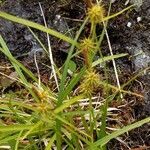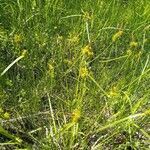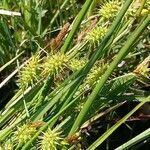Tufted, 1–8 dm; lvs flat, mostly 3–5.5 mm wide, the plants appearing leafier than no. 153 [Carex viridula Michx.]; terminal spike sessile or short-pedunculate, slender, staminate or with some distal perigynia, 6–24 mm; lateral spikes 2–5, pistillate, short and stout, 6–17 mm, all sessile or short-pedunculate and crowded at the summit, or 1 or 2 of the lower ± remote and more evidently pedunculate; bracts sheathless or nearly so (except those subtending any remote spikes), one or more of them with an elongate blade much surpassing the infl; pistillate scales strongly tinged with coppery brown, thus conspicuous in the spike; perigynia 3.7–6.2 mm, most of them spreading and evidently falcate-recurved, relatively slender and gradually tapering to the poorly defined, distally rough-margined beak, this 1.4–2.3 mm, set at a ± divergent angle to the body; perigynium-body strongly yellowish toward the base, usually more greenish (or eventually brownish) distally, prominently several-nerved on the upper surface, more obscurely so on the lower, achene hardly larger than in no. 153, a larger part of the perigynium thus empty; 2n=60, 64, 68, 70. Bogs and wet meadows in calcareous districts; circumboreal, s. in Amer. to N.J., Ind., Ida., and B.C. (C. laxior)
More
Plants cespitose. Culms straight, 10–75 cm. Leaves of flowering stems shorter than to slightly exceeding culms, 5–30 cm × 1.6–4.7(–5.8) mm; ligules on distal cauline leaves truncate or rounded. Inflorescences: peduncles of terminal spikes 0.4–5(–9) mm; bracts to 18.5 cm × (0.7–)2–4.5 mm; inner band of sheaths truncate or concave. Spikes: proximal pistillate spikes (1–)2–5, contiguous or approximate, globose to elliptic, 8–22 × 7.5–12.7 mm; terminal staminate spikes sessile or pedunculate, 9–22 × 1.1–3 mm. Scales: pistillate scales reddish brown, 2.3–3.9 × 0.9–1.4 mm; staminate scales reddish brown, ovate, margins narrowly whitish hyaline, apex obtuse. Anthers 1–2.1 mm. Perigynia reflexed, bright yellow at maturity, 4–6.3 × 1–1.9 mm, apex gradually narrowed; beak 1.3–2.7 mm, forming angle of (15–)26–72° with body, scabrous. Achenes 1.3–1.7 × 0.9–1.2 mm. 2n = 60.












